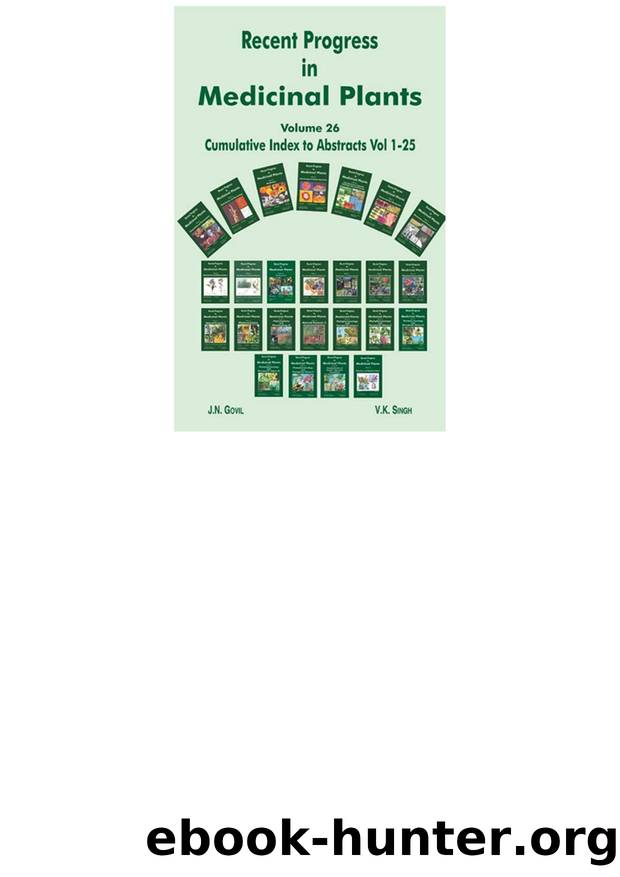Recent Progress in Medicinal Plants: Cumulative Index to Abstracts Vols. 1-25 by J. N. Govil & V. K. Singh

Author:J. N. Govil & V. K. Singh [Govil, J. N. & Singh, V. K.]
Language: eng
Format: epub
ISBN: 9781933699165
Google: CHUEywAACAAJ
Publisher: Studium
Published: 2010-09-15T21:32:03+00:00
Chapter 5
Insecticidal & Piscicidal Activity
05-2003-02-08-0654-RAJENDRA PRASAD, Y. AND BABY, P. (Division of Organic Chemistry, Government College, Rajamundry 533 105, A.P., India) Phytochemicals â The Potential Biopesticides for Future. In: Phytochemistry and Pharmacology, V. 2, p 5 (Ref 11).
Usage of synthetic pesticides to control pests has a number of disadvantages. Many phytochemicals possess antifeedant, grain protectant activities and act as effective pesticides. Administration of phytochemicals as viable alternatives to pesticides is suggested.
05-2002-05-19-0655-GIOVANNI SANNA-PASSINO, EMANUELA BAZZONI, MARIO D.L. MORETTI (Dipartimento Protez. Piante. Sez. Entomologia Agraria, Via de Nicola, 07100 Sassari, Italy) Recent Studies on Essential Oils Formulations Used for Control of Insect Pests of Cultivated Plants. In: Crop Improvement, Production Technology, Trade and Commerce, V. 5, p 16 (Ref 66).
Wide range investigations of essential oils useful in the control of the phytophagous insects have demonstrated and enormous progress in the field. Their actions could be attributed to the interference with metabolic, biochemical, physiological, and behavioral functions of insects. Earlier evaluations have established their activity as ovicides, fumigants, and contact toxicants. Some essential oils exhibit acute toxicity, whereas other are attractive or repellents, antifeedants or affect on growth and development or reproduction. In the last ten years, great advances have been made in laboratory and field studies about use of the essential oils for the control of many insect pests. Activity, mechanism of action and useful formulations are discussed for the following insect orders: Diptera, Lepidoptera, Coleoptera, Orthoptera, Isoptera, Hymenoptera and Homoptera. In particular, the problems related to the volatility of the oils and their poor solubility in water have been discussed for an optimal application in field.
05-2002-06-01-0656-SINHA, P. (Division of Plant Pathology, Indian Agricultural Research Institute, New Delhi 110 002, India) Overview on Diseases of Medicinal Plants and their Management. In: Diseases and their Management, V. 6, p 6 (Ref 8).
Indian subcontinent is endowed with varied agroclimates and topography. Therefore, it is one of the richest plant biodiversity of the world and rightly acclaimed as âBotanical garden of the worldâ. Among the ancient civilizations, Indian subcontinent has been known to be a rich repository of medicinal plants. The Rigveda (5000 B.C.) mentioned 67 medicinal plants, Yajurveda 81 and Atharvaveda (4500-2500 B.C.) 290 species. Charak Samhita (700 B.C.) and Sushruta Samhita (200 B.C.) have described properties and uses of 1,100 and 1,270 plants, respectively, in compounding of drugs and these are still used in classical formulations in the Ayurvedic system of medicine. Unani and Sidha system of medicines also utilize number of plants for medicinal purpose. Medicinal plants yield variety of complex chemical substances including glycosides, alkaloides and essential oils. The current worldwide trend towards the utilization of these natural plant products has created an enormous need for information about the properties and uses of these plants. Progress in medicinal plants research has undergone a phenomenal growth during the last couple of decades. Drugs therapy based on traditional system of medicine employing herbs forms a major therapy because of its no sideeffects. India accounts for 8% global biodiversity which exists in 2.4% land area of the world.
Download
This site does not store any files on its server. We only index and link to content provided by other sites. Please contact the content providers to delete copyright contents if any and email us, we'll remove relevant links or contents immediately.
Sapiens: A Brief History of Humankind by Yuval Noah Harari(14256)
Sapiens by Yuval Noah Harari(5295)
Pale Blue Dot by Carl Sagan(4917)
Homo Deus: A Brief History of Tomorrow by Yuval Noah Harari(4827)
Livewired by David Eagleman(3686)
Origin Story: A Big History of Everything by David Christian(3651)
Brief Answers to the Big Questions by Stephen Hawking(3369)
Inferior by Angela Saini(3278)
Origin Story by David Christian(3149)
Signature in the Cell: DNA and the Evidence for Intelligent Design by Stephen C. Meyer(3075)
The Gene: An Intimate History by Siddhartha Mukherjee(3050)
The Evolution of Beauty by Richard O. Prum(2939)
Aliens by Jim Al-Khalili(2788)
How The Mind Works by Steven Pinker(2732)
A Short History of Nearly Everything by Bryson Bill(2631)
Sex at Dawn: The Prehistoric Origins of Modern Sexuality by Ryan Christopher(2483)
From Bacteria to Bach and Back by Daniel C. Dennett(2448)
Endless Forms Most Beautiful by Sean B. Carroll(2431)
Who We Are and How We Got Here by David Reich(2399)
